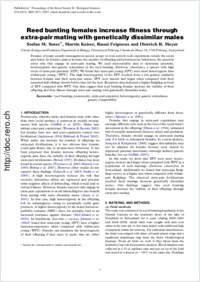Reed bunting females increase fitness through extra-pair mating with genetically dissimilar males
- Suter, Stefan M. Unit for Ecology and Evolution, Department of Biology, University of Fribourg, Switzerland
- Keiser, Martin Unit for Ecology and Evolution, Department of Biology, University of Fribourg, Switzerland
- Feignoux, Raoul Unit for Ecology and Evolution, Department of Biology, University of Fribourg, Switzerland
- Meyer, Dietrich R. Unit for Ecology and Evolution, Department of Biology, University of Fribourg, Switzerland
-
2007
Published in:
- Proceedings of the Royal Society B: Biological Sciences. - 2007, vol. 274, no. 1627, p. 2865-2871
reed bunting
promiscuity
extra-pair paternity
heterozygosity
genetic relatedness
genetic compatibility
English
Females of many socially monogamous species accept or even actively seek copulations outside the social pair bond. As females cannot increase the number of offspring with promiscuous behaviour, the question arises why they engage in extra-pair mating. We used microsatellite data to determine paternity, heterozygosity and genetic relatedness in the reed bunting (Emberiza schoeniclus), a species with high levels of extra-pair paternity (EPP). We found that extra-pair young (EPY) were more heterozygous than within-pair young (WPY). The high heterozygosity of the EPY resulted from a low genetic similarity between females and their extra-pair mates. EPY were heavier and larger when compared with their maternal half-siblings shortly before they left the nest. Recapture data indicated a higher fledgling survival of EPY compared with WPY. Our data suggest that reed bunting females increase the viability of their offspring and thus fitness through extra-pair mating with genetically dissimilar males.
- Faculty
- Faculté des sciences et de médecine
- Department
- Département de Biologie
- Language
-
- English
- Classification
- Biological sciences
- License
-
License undefined
- Identifiers
-
- RERO DOC 8390
- DOI 10.1098/rspb.2007.0799
- Persistent URL
- https://folia.unifr.ch/unifr/documents/300418
Statistics
Document views: 181
File downloads:
- pdf: 170
